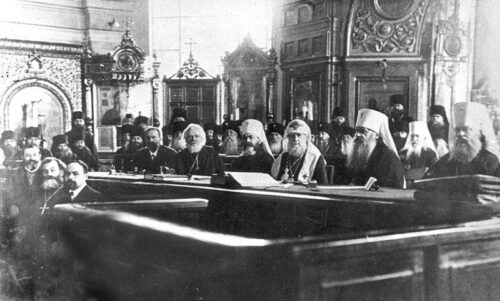
Russia’s political system at the turn of the 20th century was one of the most backward in Europe. It was one of the few remaining autocracies: all political power and sovereignty were vested in a hereditary monarch, the tsar (a term derived from the Latin ‘Caesar’). The tsar was bound by only two restrictions: adherence to the Russian Orthodox Church and the laws of succession. In all other matters, the tsar and his will were considered supreme. Unlike most other nations, Russia had no constitution, no elected representative assembly, no democratic processes within the national government, no high court or court of appeal that could examine or restrain the tsar’s laws. Tsarist government was essentially government by decree: the tsar issued declarations or proclamations and his ministers, governors and bureaucrats implemented them.
Russia’s size meant that tsarist government relied on a vast second-tier of officials and administrators. Beyond the boundaries of Saint Petersburg, the Russian empire was divided into 34 guberniyas (provinces) and oblasts (remote regions). Each of was administered by a governor, who had Imperial Army or police units at his disposal. Governors were responsible for promulgating, implementing and enforcing the tsar’s laws within each province. In reality, Russia’s enormous size and the distance of some provinces from the capital allowed governors a degree of autonomy. After reforms implemented in 1864, each guberniya also contained a number of zemstva: local councils that could collect taxes and provide services such as education, public health and transport. Though the zemstva were often dominated by land-owning nobles, they still contained representatives from all classes, including the peasantry. In 1890 Alexander III crippled the zemstva by reducing their autonomy and requiring their decisions to be endorsed by the royal governor.

To most Russians, the public face of the government was its bureaucracy. Russia’s huge public service was charged with enforcing regulations, collecting taxes and duties, maintaining records and so on. Bureaucrats were a visible presence in cities and large towns, where they wore distinctive uniforms and held one of 14 different ranks, equivalent to those in the military. The majority of bureaucrats were neither well educated or well paid, which made them susceptible to corruption and bribery. Even low-ranking bureaucrats had the capacity to make decisions arbitrarily – from issuing dog licences to approving land titles – so it was quite common for them to demand bribes or gratuities to facilitate approval. Some were little more than petty bullies. The Imperial Russian bureaucracy imposed itself on the lives of ordinary Russians more than any other arm of the government. The lower classes viewed the bureaucracy as petty, officious, greedy and corrupt; they were obsessed with paperwork and overly fond of wielding power for its own sake. Criticism or condemnation of bureaucrats was a consistent theme in 19th century propaganda and doggerel.
“The alienation of Russian society from its government grew steadily in the 1860s and 1870s. The intelligentsia defined itself by opposing the Russian state which allowed it no direct political role. The tsarist regime’s unwillingness to introduce even a conservative constitution meant that many middle-class professionals and businessmen could not see the tsarist state as supporting their interests. But the more immediate threat to the status quo came from radicals, mainly young university students who concluded that reform had run its course and failed.”
Theodore R. Weeks, historian

1. Tsarist government was predicated on the tsar’s supreme autocratic power, which was inviolable.
2. Tsarism had no democracy, representation or accountability at higher levels. All officials were chosen by the tsar.
3. Beyond the capital, tsarist decrees were implemented and enforced by provincial governors and bureaucrats.
4. The bureaucracy was the public face of the government but was widely despised for its corruption and officiousness.
5. Tsarism was also supported by conservative groups like the Black Hundred that sprang up in the early 1900s.
© Alpha History 2018. Content on this page may not be republished or distributed without permission. For more information please refer to our Terms of Use.
This page was written by Jennifer Llewellyn, John Rae and Steve Thompson. To reference this page, use the following citation:
J. Llewellyn et al, “Tsarist government” at Alpha History, https://alphahistory.com/russianrevolution/tsarist-government/, 2018, accessed [date of last access].

